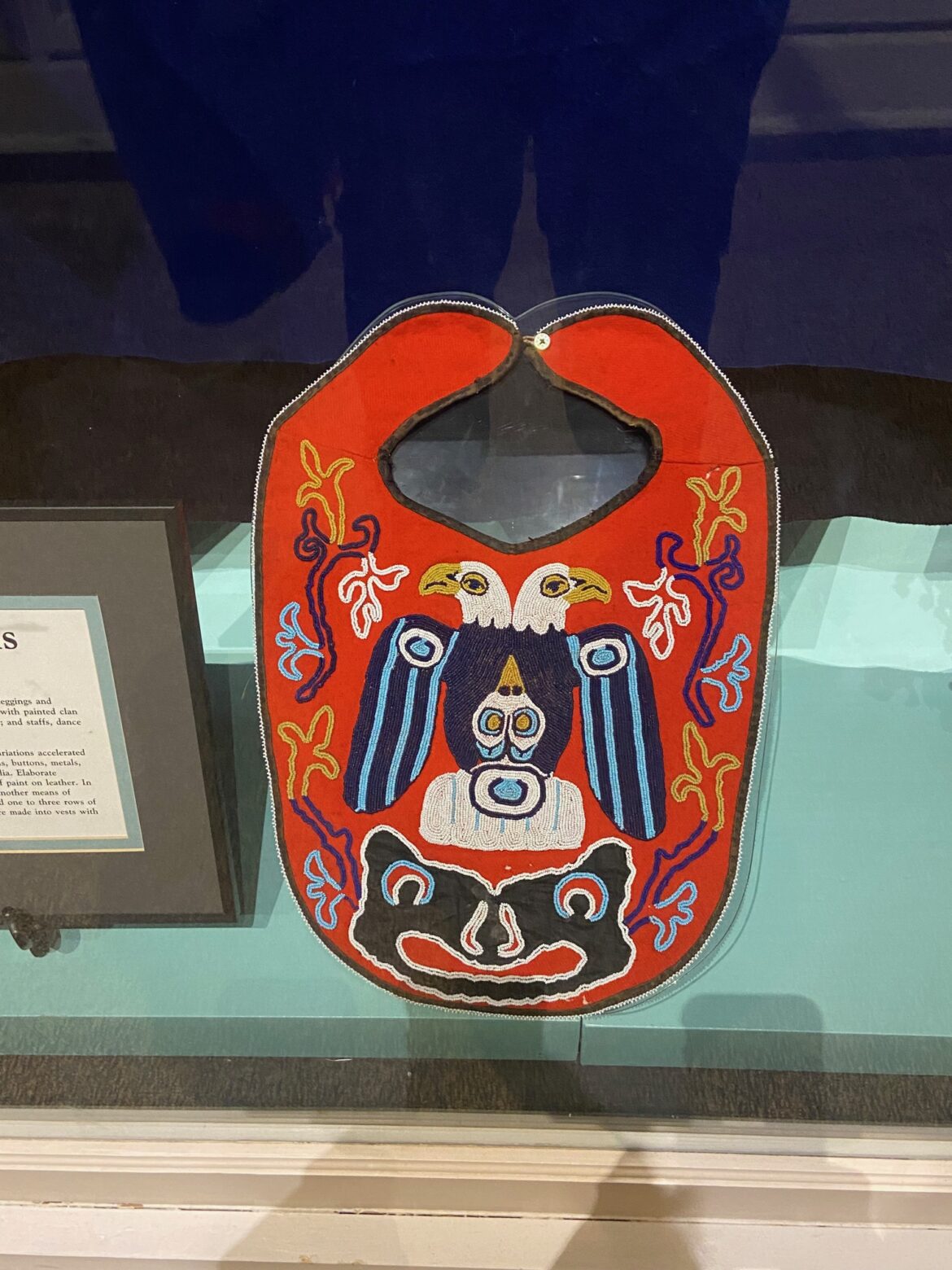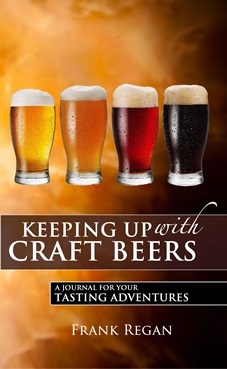Disclosure: This post may have affiliate links and we may earn compensation when you click on the links at no additional cost to you.
What I Learned on a cruise to Alaska
First, what I learned on a cruise is that Alaska is much, much larger than I ever realized. The typical map that shows the Continental U.S. and then insets off to the side with Hawaii and Alaska do Alaska a disservice.
During the cruise we were on, a retired U.S. Park Ranger gave some lectures. In one, she showed a map of the Continental U.S. with Alaska superimposed upon it. Yikes! Alaska, with it’s island possessions, stretches from Florida and covers an incredible amount of the U.S. land mass up to the Canadian border. It was truly a bargain purchase from Russia.
What I learned on an cruise is that Alaska is more isolated than you’d think.
Much accessible only by plane or boat.
Parts of it are not attached to either the larger land mass where Anchorage and Mt. Denali are or to the Continental U.S.
In other words, you have to cross through Canada if you want to go even part way via land.
The cruise to Alaska didn’t take us to the larger land mass where the bulk of the population lives, but only to coastal and island towns. So, while you may cruise to Alaska, you are only cruising to a tiny portion of it. You can only reach Juneau, the capital of Alaska, by sea or air. No roads lead to the city.
I learned that parts of Alaska, those along the coast, are more moderate in temperature and less snowy than expected. A tour bus driver mentioned that they only got about 16 inches of snow, as a rule. It may be more misty and rainy, than snowy.
Because you can only access some of Alaska by sea or plane, prices for food and supplies are high. In Hoonah we heard that milk is $17 a gallon and it’s hard to get eggs, unless you own or know someone who owns chickens.
What I learned on a cruise is that Alaska is much more than glaciers and Polar Bears
The part of Alaska that we visited is very sea-oriented. Some of the places we visited were actually islands, not the mainland. The population hugs the coastline. There are bears, but not Polar Bears, who are struggling to survive much farther North.
Where we visited, much of the population seemed to be involved in the tourist industry. Icy Strait Point, we were told, was basically created by the locals to capitalize on the cruise ship visits to the area. They only open when a ship is in port. Attractions include a restored 1912 Alaska salmon cannery and museum, nature trails, restaurants, 100% Alaskan-owned retail shops, zipline, whale and wildlife watches, and more.
Here’s part of the display of the vintage cannery machinery at the Cannery Museum in Icy Strait Point:

It also capitalized on the steepness of the terrain with the SkyGlider gondolas that ascend to 1,600 feet of elevation at Sky Peak. The 54 cabins each hold eight passengers, all enjoying window seats. The cabins accommodate wheelchairs. The SkyGlider almost soundlessly moves above a magnificent rain forest and offers a great view. Unfortunately we were there on a rainy day, but still enjoyed the experience.
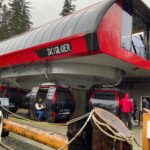
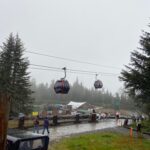
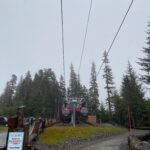
Note: there is a free Transporter gondola service that gets Wilderness Landing cruise ship guests closer to the Cannery area and Ocean Landing cruise ship guests close to the SKYGLiDER to reach the top of the mountain.
For those with mobility issues there is a shuttle service from the piers to the gondolas.
After riding the Skyglider, we took a shuttle bus ($5) into the town of Hoonah. We checked out two restaurants that we found along the waterfront. They both only had outside, if sheltered, seating. As it was a raw, windy and rainy day, we ended up for the inside warmth of Icy Strait Brewing, which is also where the shuttle bus leaves from to take us back to our starting point.
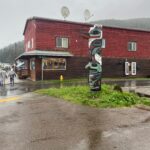
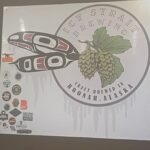
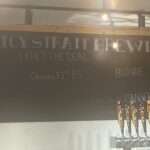
It was surprising to find a brewery in such a humble town, but the selection and taste of the beer was great. The price was in line with those in the New England area.
Alaska has several similarities to Maine
People from all over the U.S. fall in love with the area and move there, despite the challenges. Which we have found in DownEast Maine.
The seacoast and reliance on shipping and ocean-related industries is similar. The salmon industry is also prominent to both coasts.
Sea and land creatures and vegetation are of general similar appearance: whales, birds, trees. Whales seemed a little more common, at least where we traveled. Seagulls and robins, or robin like birds, were similar to the eye.
The mountains in Alaska are higher and the crevices in between deeper, at least to the eye, but it’s as if the mountains in Alaska are enlarged and more snow capped than in Maine.
What I learned on a cruise is that Alaska’s Indigenous People are much more than Eskimo or Inuit
I learned that Alaska’s Indigenous People are resilient and of more different groups than Inuit. The museums we went to had astounding and enlightening artifacts from dozens of tribes.
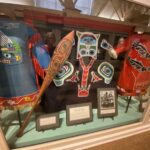
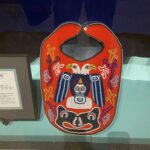
In Sitka, we visited the Sheldon Jackson State Museum. It is in a very modest looking octagonal building that doesn’t reflect the extensive and fabulous collections inside. The curators make excellent use of the space, and tells stories through the exhibits of Alaskan Native Peoples of many nations and tribes. Traditional clothing, masks, baskets, totems, and kayaks and more delight, stun, and educate.
Remembering hearing that Native People use everything from animals, there’s proof in the clothing and useful items made from the skin, gut, and intestines of larger sea animals. An example is a baidarka, a traditional skin-covered watercraft used by the Aleut and Alutiiq people. They made bags out of gut and bladders.
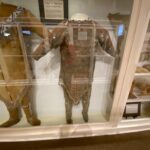
In Juneau, we visited the Alaska State Museum, which also displayed an incredible variety of artifacts from Alaskan Native Peoples.
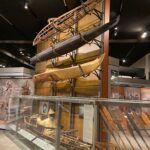
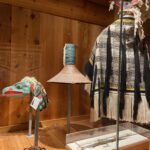
Totem poles are very much a part of Alaska’s cultural heritage. Sitka in particular has a totem park and a walking trail of totem poles. The museums also feature examples.
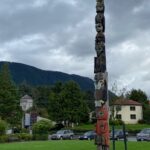
Indigenous craftspeople still spend months making them.
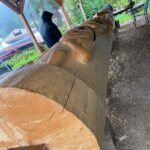
What I learned about Alaskan Wildlife while on a cruise
While when you think of Caribou, you think of Canada, they actually also live in Alaska, and thousands, upon thousands migrate from northern Alaska across Canada.
Salmon: there are several varieties of salmon in Alaska. Like the Atlantic salmon, those in the Pacific are also threatened by man affecting their habitants.
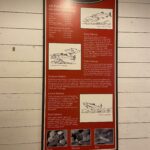
It’s very common to see whales, even from the shore. We saw multiples of Orca surfacing and blowing and then diving with a flip of their tails. We also saw them as we were cruising from the ship when we were along the Alaskan coast. You didn’t have to take a special tour to see them.
What I learned on a cruise about Glaciers in Alaska
First of all, our cruise itinerary included Endicott Arm and Dawes Glacier. Well, we got to see icebergs from the glacier, but not the glacier. We were partially through the fjord when the ship’s captain announced that we were turning around. It seems that he was alerted that there were too many icebergs in the narrows and that it was unsafe to proceed. Our joke about seeing Alaska before it melts was unfortunately not a joke. Evidently the glacier was calving at a rapid rate.
When we got off the ship in Juneau, we signed up for a city and glacier tour by bus. Well, the city tour was brief and then the bus took us off to Glacier national Park, which was stunning. The driver was, half Irish and half Indigenous extraction. He told local cultural stories about the bear and raven as he drove along.
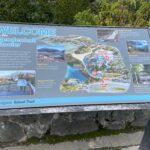
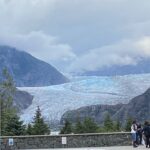
We were dropped off in the parking lot near the Mendenhall Glacier where there is access to several walking trails. We followed several of the lower trails and viewed the glacier and the lake that it is calving into. The Mendenhall Glacier was eerie looking, like a river that was flash-frozen.
The Mendenhall Glacier Visitors Center offered several amenities and a short film. The trails we took were all relatively easy. The Trail of Time, which connects to East Glacier Loop, includes historical signs and handicapped accessibility. We had plenty of time to wander and take in the Mendenhall Glacier and the Visitors Center before the bus returned.
To wrap up what I learned on a cruise to Alaska
I learned that I should have studied up more about Alaska before the cruise. I did leaf through an old cruise book, that covered the usual ports: Sitka and Skagway and Juneau, but it didn’t prepare me for where we actually were going. I confess I didn’t realize that we would only experience a fraction of the state. Also where we were docked was touristy and we didn’t get much of the local culture, with some exceptions. Taking the shuttle bus to the community of Hoonah, as opposed to the “made for tourist consumption” restaurants and shops was seeing a bit of the “real” Alaska.
Waiting to sign up for excursions until we landed worked for us, as the weather was a factor as far as enjoyment.
Also, our itinerary was changed due to unforeseen circumstances. Icy Strait Point was substituted for Skagway. A Seattle Uber driver told us that Skagway had some dock issues and there was construction on the piers. We did enjoy Icy Strait Point so not upset in the substitution. As mentioned, we didn’t get to see the Dawes Glacier, which was a big disappointment.
Some of the things that we thought wouldn’t be that interesting, turned out to be fascinating and educational.
In the end, I learned that an average cruise to Alaska is just enough to whet your appetite, and more time is needed to truly appreciate the 49th state.
Have you visited Alaska? What were the high points of your trip?
Please comment below.
So many beers and breweries, how to keep track?
If you want to keep more detailed records of where you went and what beer you enjoyed, you might like Keeping Up with Craft Beers: A Journal for Your Tasting Adventures. You can list up to 100 beers, as well as list breweries and brew pubs you liked as well as beer festivals.
Want to learn how to start a blog?
Here’s some courses to get you started: Start A Travel Blog
Want or need help with your blog or website? I’ve found inexpensive help on Fiverr.
Check out our Etsy shop, GrandmotherstrunkUS

